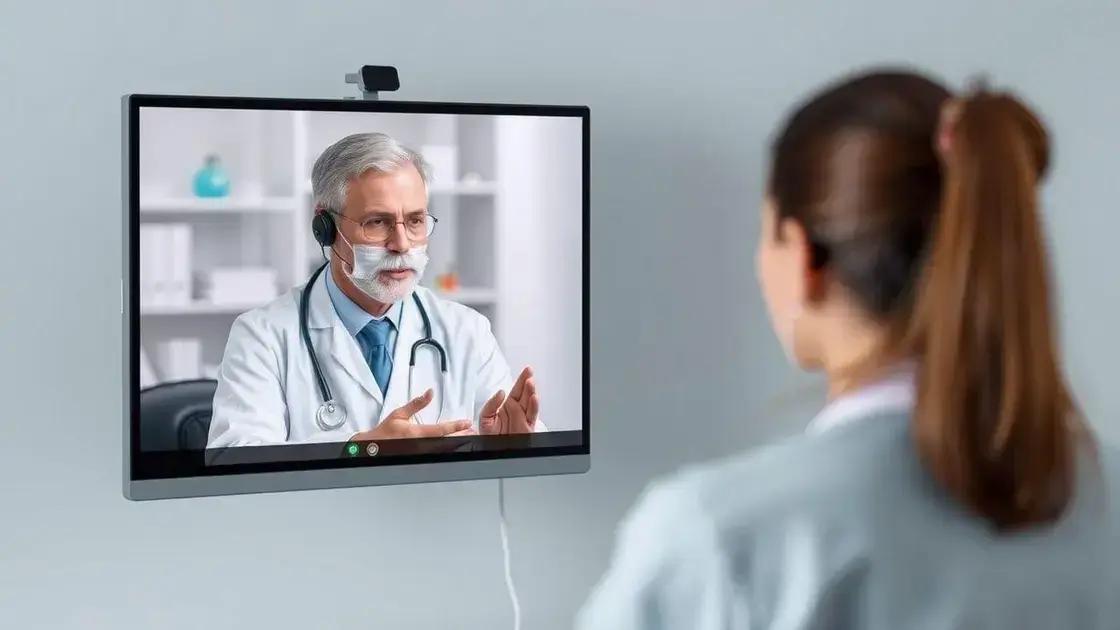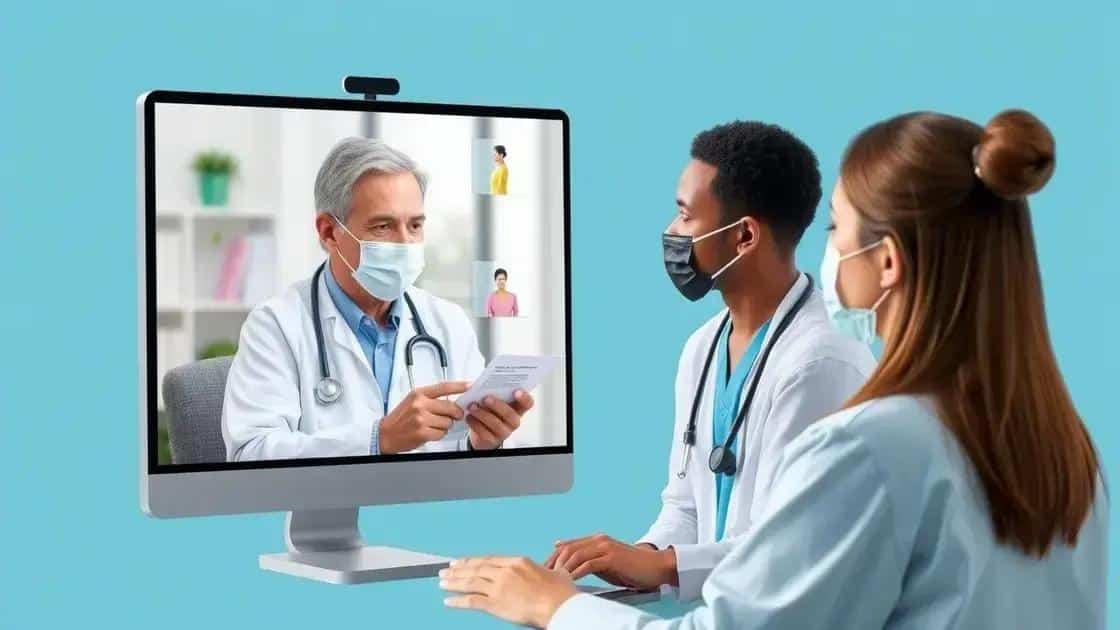Telehealth benefit expansion trends you need to know

Telehealth benefit expansion trends enhance accessibility, improve patient engagement, and integrate advanced technology, making healthcare more convenient and efficient for patients and providers alike.
Telehealth benefit expansion trends are changing the healthcare landscape, making access to care easier than ever. Have you considered how this shift impacts your own healthcare experience? Let’s dive in.
Understanding telehealth benefits
Understanding telehealth benefits is essential in today’s healthcare landscape. Telehealth offers a variety of advantages to both patients and providers, transforming the way care is delivered.
Accessibility of Care
One of the primary benefits of telehealth is its ability to improve access to healthcare services. Patients can connect with healthcare professionals without needing to travel long distances. This is especially beneficial for those living in rural or underserved areas.
Convenience and Flexibility
Telehealth provides unrivaled convenience. Patients can schedule appointments at times that fit their busy lives. Whether at home or on the go, accessing healthcare has never been easier.
- Saves time on travel
- Reduces waiting room times
- Offers secure and private communication
Furthermore, telehealth decreases the chance of exposure to illness. Patients can receive care while staying safe at home, especially during times of increased health risks.
Expanded Options for Care
Telehealth initiatives often include a range of services. This includes mental health support, chronic disease management, and follow-up care, providing patients with comprehensive options that meet their specific needs.
Additionally, telehealth facilitates better resource management. Providers can allocate their time efficiently, focusing on more patients without compromising the quality of care.
Technology in telehealth also encourages patient engagement. Patients can actively participate in their healthcare decisions, enhancing their overall experience and satisfaction.
Key trends in telehealth expansion

Key trends in telehealth expansion demonstrate how healthcare is evolving. These trends highlight significant changes that are making healthcare more accessible and efficient.
Increased Adoption of Technology
One major trend is the increased adoption of technology. More healthcare providers are using telehealth platforms to reach their patients. This change allows for real-time consultations and a more streamlined healthcare experience.
Integration with Wearable Devices
Another trend involves the integration of telehealth with wearable devices. Patients can share health data via these devices, allowing providers to monitor their conditions closely. This capability enhances patient care through continuous data tracking.
- Wearable heart and fitness monitors
- Connected health apps
- Remote patient monitoring tools
Moreover, patients are becoming more comfortable with virtual visits. Many prefer the convenience of telehealth, as it saves time and reduces the need for travel. This shift indicates a growing acceptance of digital health solutions.
Focus on Mental Health Services
There is also a noticeable focus on mental health services within the telehealth expansion. More providers are offering teletherapy options, making it easier for individuals to access mental health support. This trend addresses the rising demand for mental health services, especially during challenging times.
Insurance coverage for telehealth has expanded as well. Many insurers are now offering better coverage for virtual visits, making it a viable option for more patients. This change encourages more people to utilize these services, further embedding telehealth into the healthcare system.
Impact on patient care and access
The impact on patient care and access through telehealth is profound. As technology evolves, more patients can engage with healthcare providers from the comfort of their homes.
Improved Accessibility
Telehealth has significantly improved accessibility for various patient populations. Those living in remote areas now have easier access to specialists without costly or lengthy travel. This means timely interventions and better health outcomes.
Enhanced Patient Engagement
With telehealth, patients are more engaged in their care. They can communicate with providers through secure messaging, access test results instantly, and manage appointments without barriers. This leads to a more proactive approach to health.
- Immediate access to healthcare advice
- Greater control over health decisions
- Ability to share health data in real-time
Moreover, telehealth has proven valuable during emergencies. During health crises, such as the COVID-19 pandemic, patients sought care without risking exposure to illness. Telehealth created a bridge for ongoing care, maintaining vital communication between patients and their providers.
Tailored Care Solutions
Telehealth allows for tailored care solutions that fit the patient’s unique needs. Providers can customize treatment plans based on data gathered during virtual visits. This adaptability increases personal satisfaction and fosters better relationships between patients and healthcare providers.
The focus on chronic disease management has also grown. Patients with conditions like diabetes and hypertension benefit from regular check-ins, which telehealth can provide easily. This continuous monitoring supports better adherence to treatment plans and improved management of illnesses.
Future prospects for telehealth services

The future prospects for telehealth services are bright and full of possibilities. As technology advances, the way patients connect with healthcare providers continues to evolve.
Growth in Telehealth Usage
Research indicates that telehealth use will keep increasing. Patients appreciate the convenience and flexibility that virtual visits offer. This growth likely means more healthcare institutions will adopt telehealth solutions as part of their regular services.
Integration of Artificial Intelligence
Another exciting trend is the integration of artificial intelligence (AI) into telehealth. AI can enhance diagnostic accuracy, streamline appointment scheduling, and improve patient engagement with tailored healthcare solutions.
- AI-driven chatbots for immediate assistance
- Predictive analytics for better health outcomes
- Personalized treatment recommendations
As AI technology becomes more sophisticated, healthcare providers can better understand patient needs and deliver proactive care. This technological boost supports a more efficient healthcare system.
Enhanced Data Security
With the rise of telehealth, data security will be paramount. Patients want to know their information is safe. Future telehealth services will invest in security measures to protect patient privacy and build trust.
In addition, remote monitoring will likely expand. Patients managing chronic conditions can use devices that share real-time data with their providers. This capability allows for timely interventions and better disease management, leading to improved patient outcomes.
Finally, regulatory changes may also shape the future of telehealth. As laws evolve, reimbursement policies and coverage for telehealth services will improve. This will encourage more patients to embrace virtual care options.
FAQ – Frequently Asked Questions about Telehealth Services
What are the main benefits of telehealth services?
Telehealth services provide increased accessibility, improved patient engagement, and convenience, allowing patients to receive care from home.
How does telehealth improve patient care?
Telehealth enhances patient care by allowing continuous monitoring, better communication with healthcare providers, and quicker access to specialists.
What technology is necessary for using telehealth services?
Patients typically need a device with internet access, such as a computer, tablet, or smartphone, along with a stable internet connection.
Is telehealth secure for patient information?
Yes, telehealth platforms prioritize data security, implementing measures to protect patient information and ensure compliance with privacy laws.





